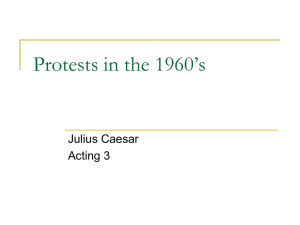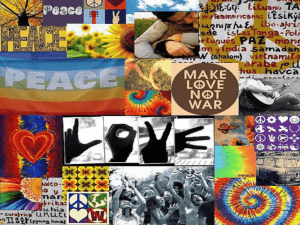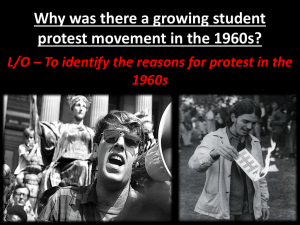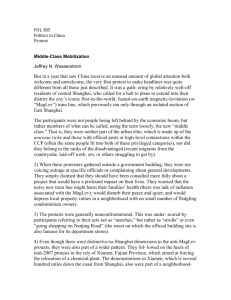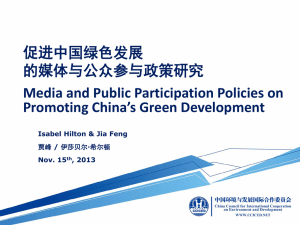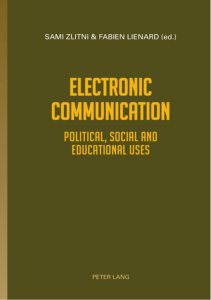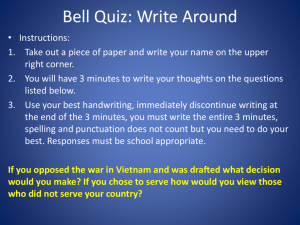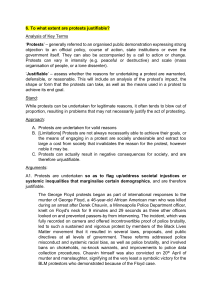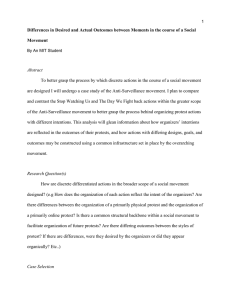Counter_Culture_and_Political_Protest
advertisement
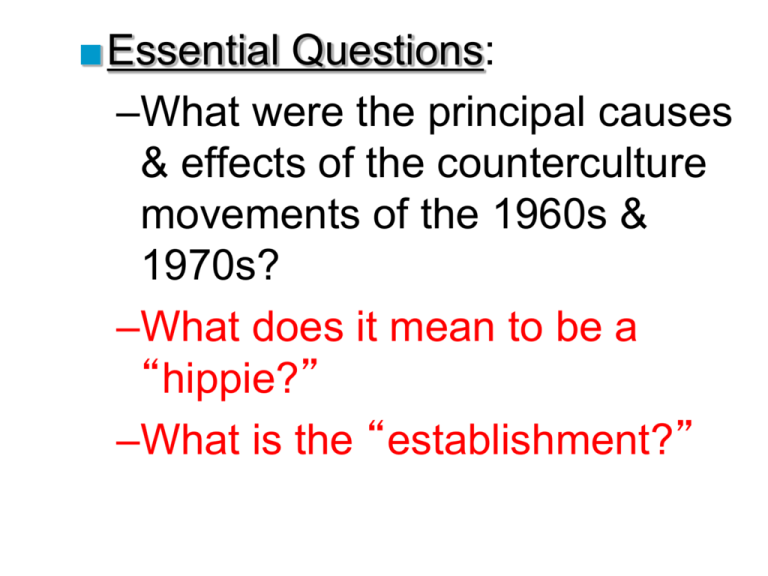
■Essential Questions: –What were the principal causes & effects of the counterculture movements of the 1960s & 1970s? –What does it mean to be a “hippie?” –What is the “establishment?” A Generation in Conflict: 1965-1974 A Decade of Protest: 1965-1974 ■The from 1965 1974 Thedecade Sixties generation wastothe best educated inby American history was marked protest dueother to: Protests against Vietnam linked social criticism—The abroad,” –Escalation of the “war Vietnam War intensified a “war at home” –Attack on middle-class values –Increased college enrollment ■The initial liberal protests began on college campuses but soon inspired other, national protests: African-Americans Mexican-Americans Native-Americans Women Hippies The Student Revolt Refused to allow Free Speech movement ■The student protest movement to collect money for off-campus causes began at UC-Berkeley in 1964 with the Free Speech movement –Students protested the “corporate face” & “1950s rules” of UC-Berkeley –Students rioted when denied a political voice on campus ■This inspired the formation of Students for a Democratic Society to end racism, poverty, & violence Mario Savio & the Free Speech riots The Berkeley protests & University of Michigan-based SDS inspired riots on campuses across the USA Brown University ended required courses & grades Many colleges ended “in loco parentis” rules The Cultural Revolution Increase inHarvard premarital professor Timothy “Summer ofLeary: Love” student protests sex■The & use of the “pill” “Let’s all try coincided LSD!! in 1967 Tune in, turn on, & drop out!” with youth counter-culture in 1965 Use of psychoactive & “Everyone must get ■Beginning in San Francisco & hallucinogenic drugs stoned,” Bob Dylan spreading throughout the US, the “hippie” culture emphasized: –Sexual expression Folk music –Clothing British invasion & electric rock –Drugs Acid rock –Music Folk singers like Joan Baez &rock” Bob Dylan “Electric (until Dylan discovered like The Beatles the electric guitar) “Acid rock” like the Grateful Dead Music was an important element to 1960s counter-culture Is this the nation’s youth?? Drugs Sex Rock ‘n’ Roll No work ethic? Mostly children from upper-middle class families Social Protests of the 1960s & 1970s “I’m black & "Black Power" I’m proud!” More than 50% ofcivil northern ■In the late 1960s, rights Brown from —James blacks lived in poverty political to economic equality –Leadership shifted from MLK’s nonviolent protest to militancy –Civil rights began to reflect the overt embrace of black culture & pride: dashikis, afros, “dap,” rejection of “slave names,” & the “black is beautiful” motto “"Black Political Power" power comes through the barrel of a gun” ■SNCC leader Stokely —HueyCarmichael: Newton –Told blacks to seize power where they outnumber whites –Called for black-controlled unions, co-ops, & political parties ■The Black Panthers dedicating themselves to defending blacks from police brutality & serving their communities “Brown Power” ■Mexican-Americans began to advocate for their rights: –“La Raza” called for cultural awareness, voter registration, education & poverty reforms –César Chávez organized the Nat’l Farm Workers' Assoc to demand better pay for pickers –“Chicanos” called for & won bilingual education programs “Pink Power” Growth of female-run small businesses helped overcome corporate movement “glass ceiling” ■Women's Liberation demanded rights & In 1973, theincreased Supreme Court upheld thev Wade late 1960s, In thean1960s, women abortion rights ininIn Roe end to sexism America: most became families, were still employed in But…in the “pill” –Friedan’s Mystique both parents worked widely available stereotypical jobs…Feminine out of criticized housewife lifethe home …were still seen as …& unmarried –Nat’l Org of Women calledadults for “homemakers” outnumbered married equal pay, child care, rape laws, adults for the first time & anti-abortion laws –Equal Rights Amendment was revived to end sexism TheState ERA Voting by fell 3on states of the shy ERA the ¾ needed for ratification “Rainbow Power” ■The Gay Liberation movement started in 1969 after the Stonewall Riot in New York City –The Gay Liberation Front demanded end to discrimination & rallied gays to “come out” –The American Psychiatry Assoc ended its classification of homosexuality as a disease –½ of all states changed their sodomy & employment laws “Red Power” Resulted in marches on the Bureau of Indian ■The American Indian movement Affairs in D.C. & Wounded Knee in S.D. sought to service its communities A 5-month protest California to D.C. & regain lost from lands: to protest past U.S. treaty violations –“Indians of All Tribes” took Alcatraz Island in 1969 & called attention to the movement –“Trail of Broken Tears” in 1972 & “Long March” in 1978 helped lead to the return of lands across the country to tribes “Yellow Power” ■The Asian-American movement began with the formation of the Asian American Political Alliance: –Protested U.S. involvement in Vietnam & use of term “gooks” –Called for & received AsianAmerican studies in colleges, health services in Asian communities, & reparations for interned Japanese-Americans Civil Liberties ■Civil liberties were protected for people accused of crimes: –Gideon v Wainwright (1963)— all citizens, no matter the crime, have the right to an attorney –Escobedo v Illinois (1964)— citizens have the right to remain silent during interrogations –Miranda v Arizona (1966)— suspects must be told of their right against self-incrimination Conclusions ■The counterculture & “power protests” used similar “Black is Beautiful,” “Gaymethods: is Good,” & “Sisterhood is Powerful” –Active & often-militant protest for civil & economic rights –Cultural pride & awareness ■These protests would continue but would faced confrontation by the conservative politics of the 1970s & 1980s
